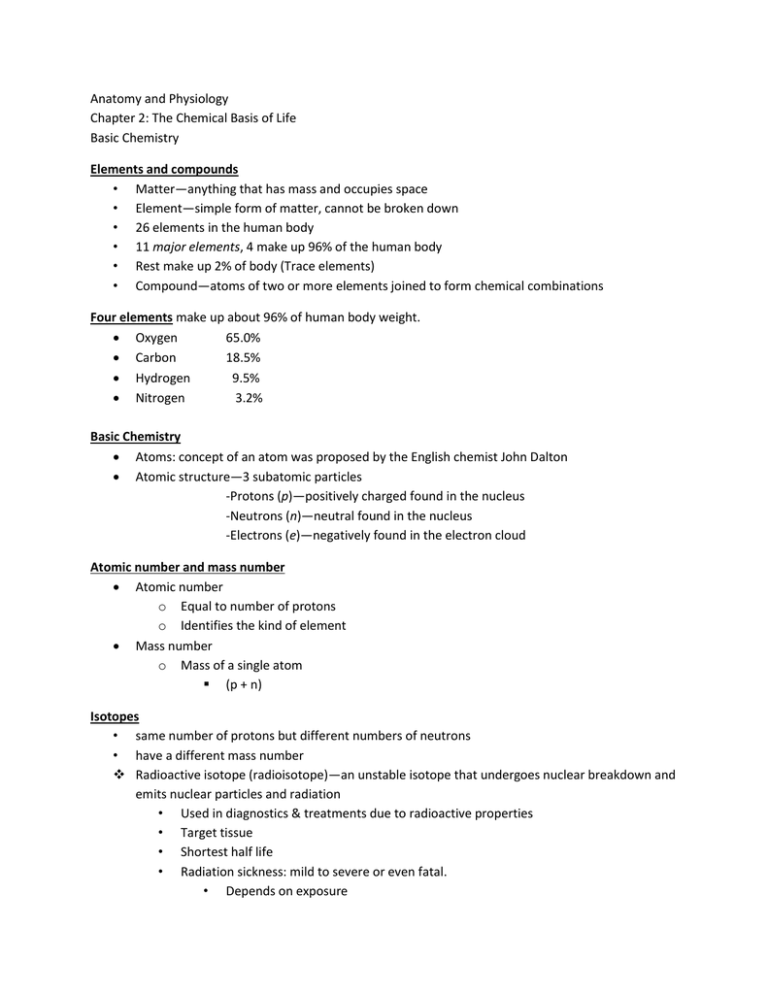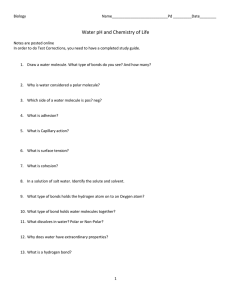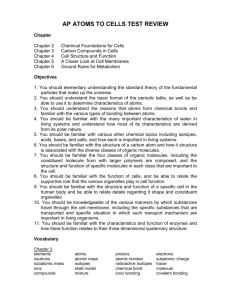Chapter 2 NOTES
advertisement

Anatomy and Physiology Chapter 2: The Chemical Basis of Life Basic Chemistry Elements and compounds • Matter—anything that has mass and occupies space • Element—simple form of matter, cannot be broken down • 26 elements in the human body • 11 major elements, 4 make up 96% of the human body • Rest make up 2% of body (Trace elements) • Compound—atoms of two or more elements joined to form chemical combinations Four elements make up about 96% of human body weight. Oxygen 65.0% Carbon 18.5% Hydrogen 9.5% Nitrogen 3.2% Basic Chemistry Atoms: concept of an atom was proposed by the English chemist John Dalton Atomic structure—3 subatomic particles -Protons (p)—positively charged found in the nucleus -Neutrons (n)—neutral found in the nucleus -Electrons (e)—negatively found in the electron cloud Atomic number and mass number Atomic number o Equal to number of protons o Identifies the kind of element Mass number o Mass of a single atom (p + n) Isotopes • same number of protons but different numbers of neutrons • have a different mass number Radioactive isotope (radioisotope)—an unstable isotope that undergoes nuclear breakdown and emits nuclear particles and radiation • Used in diagnostics & treatments due to radioactive properties • Target tissue • Shortest half life • Radiation sickness: mild to severe or even fatal. • Depends on exposure • • Mild: Nausea, headaches Extreme: Leukemia, Sterility, birth defects, skin damage Chemical bond: The electrical attraction between atoms Three types of chemical bonds o Ionic bond: Caused by a transfer of electrons between atoms o Covalent bond: Involves a sharing of electrons by the outer shells of the atom Strength goes up with shared bonds Unequal charge distribution on molecules (Polarity) o Hydrogen bond: An intermolecular attraction, no transfer of electrons weakest of bonds Metabolism: all of the chemical reactions that occur in body cells (2 main types) Catabolism o Chemical reactions break down complex compounds into simpler ones and release energy E.g.: hydrolysis is a common catabolic reaction Uses water to break down things Products of catabolism are carbon dioxide, water, and other waste products Releases ATP Anabolism o Use simple molecules together to build complex molecules o Dehydration synthesis (condensation) Joins two things and loses water o Requires ATP Organic and Inorganic Compounds Inorganic compounds-few have carbon atoms and none have C—C or C—H bonds o Water Most abundant compound in the body Properties of water Polarity: effective solvent in the body Ionizes substances in solution Lubricant Transport medium Protection/Cushioning o Oxygen and carbon dioxide—needed for cellular respiration Oxygen—necessary for the release of energy in the body Carbon dioxide—waste product and helps maintain acid-base balance in the body o Electrolytes Large group includes acids, bases, and salts Form ions (called electrolytes). Cations: Na+, K+ Anions: Cl-, I- Acids and bases—chemical opposites Acids o Any substance that releases a hydrogen ion (H+) when in solution—proton donor o Level of acidity depends on the number of hydrogen ions a particular acid will release Bases o Dissociate to yield hydroxide ions (OH-) or other electrolytes that combine with hydrogen ions (H+) o Described as proton acceptors pH scale—assigns a value to measures of acidity and alkalinity Scaled from 0-14 pH of 7 indicates neutrality (equal amounts of H+ and OH-) pH less than 7 indicates acidity pH higher than 7 indicates alkalinity Buffers Salts Maintain the constancy of pH Minimize changes in the concentrations of H+/OH- ions Results from chemical interaction of an acid and a base o Called a neutralization reaction Organic compounds: o A least one carbon atom & at least 1 C–C or C–H bond in each molecule o Functional groups attached to the molecule Carbohydrates- contains C, H, and O(usual ratio 1:2:1) o Called sugars and starches Monosaccharaides simple sugars with short carbon chains Glucose Fructose Galactose Disaccharides two (di-) Sucrose: (glucose + fructose) Maltose: (glucose + glucose) Lactose: (glucose + galactose) Polysaccharidesmore (poly-) simple sugars that are bonded together Glycogen (animal) Starch (plants) Lipids: water-insoluble important for compounds: Fats, Steroids, Prostaglandins, & Phospholipids o Major roles: Energy source Cushioning for internal organs Integral parts of cell membranes o Fatty acids Most abundant of lipids and most concentrated source of energy Types of fatty acids: Saturated fatty acid (all available bonds are filled) o Animal fats o Solid at Room Temp Unsaturated fatty acid (has one or more double bonds) o Plant oils o Liquid at room temp o Can be broken down faster which means they are “healthier” Phospholipids o One end is water soluble (hydrophilic) o Other end is fat soluble (hydrophobic) o Can join two different chemical environments o Form double layers called bilayers that make up cell membranes Steroids (sterols) o Structural and functional roles o Cholesterol: needed to survive ONLY ANIMALS CONTAIN CHOLESTEROL not plants Prostaglandins o Tissue hormones: produced by cell membranes throughout the body o Response to a specific stimulus and then inactivated Protein: Most abundant organic compounds, Amino acids form peptide bonds All contain C, H, O, and N Functional: o Enzymes: Anything ending in –ase is an enzyme o Antibodies o Hormones Amino acids—building blocks of proteins Essential amino acids o 8 amino acids that cannot be produced by the adult human body Nonessential amino acids o 13 amino acids can be produced in the adult human body Nucleic acids and related molecules DNA (De-oxy-ribo-Nucleic Acid) o 2 chains of deoxyribonucleotides coiled into a double-helix shape o (twisted ladder) RNA (Ribonucleic Acid) o Single strand, DNA copies o Make proteins






